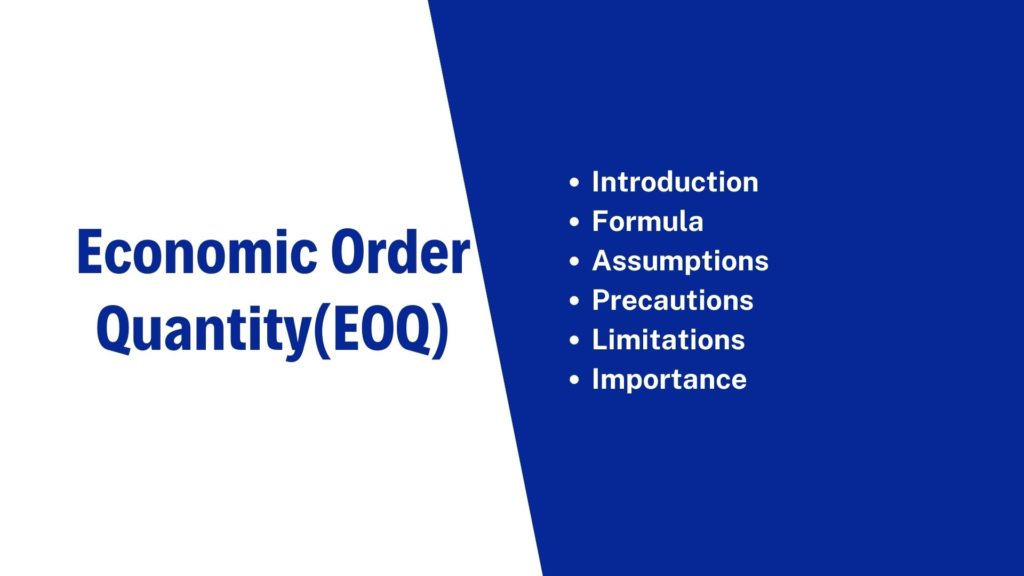Formula of EOQ – Economic Order Quantity Meaning | Free Cost Accounting Articles
Table of Contents
Formula of EOQ

ECONOMIC ORDER QUANTITY
The Economic Order Quantity (also known as re-order quantity) refers to the size of the order which gives the maximum economy in purchasing any material. It is an optimum or standard order size. When the stock reaches the recorder level, the company should give a fresh order of optimum size.
This quantity is also called “Economic Purchase Quantity, or Economic lot size, or optimum lot size or Minimum Cost Inventory.”
In fixing the economic order quantity, the following costs are considered:
1) Ordering Cost
This is the cost of placing an order with the supplier and includes the cost of stationery, salary of those who are engaged in placing an order and in receiving and inspecting the materials. It is a fixed cost and therefore cost of placing an order varies from time to time depending upon the number of orders placed and the quantity of items ordered. The number of orders increases, the ordering cost goes up and vice-versa.
2) Inventory Carrying Cost
It is the cost of holding the stock in storage and includes interest on investment, obsolescence losses, storekeeping cost, such as rent of warehouse, the salary of the storekeeper, stationery used in maintaining records of stores, etc, insurance cost, deterioration and wastage of material. The larger the volume of inventory, the great will the inventory carrying cost and vice-versa.
The above two costs are of opposite nature. If for example, an attempt is made to reduce inventory carrying cost by holding the stores as low as possible, the number of orders will increase and consequently, the ordering cost will go up. On the other hand, if orders are placed for a larger quantity, the inventory carrying cost will increase and ordering cost, the economic order quantity (EOQ) is fixed to keep the aggregate cost to the minimum.
Assumptions of Economic Order Quantity (EOQ)
The EOQ model is based on the following assumptions:
(i) There is only one product involved
(ii) Annual usage (demand) requirements are known
(iii) Usage is spread evenly throughout the year so that the usage rate is reasonably constant
(iv) Lead time does not vary
(v) Each order is received in a single delivery and
(vi) There are no quantity discounts.
Precautions in Applying EOQ
The following precautions are necessary for applying E.O.Q.
1) Simplification of Routine
If the E.O.Q. formula tells us that 13 orders have to be placed in a year, we may place 12 orders, i.e. once a month.
2) Ordering in Package Sizes
Many goods are packed in units of one gross. If the figure shows a quantity of 11 dozens, it should be changed to 12 dozens.
3) Economical Freight Rates
If the mathematical figure gives 9/10th of a lorry or rail wagon load, it is better to increase the quantity to have one full lorry load or one full wagon load. This would be cheaper because the full wagon load rates would be lower than transporting the material as small.
4) Perishable Articles
For perishable articles whose shelf-life is very low, E.O.Q. should be much less than the theoretical figure and should be based on practical considerations.
5) Seasonal Articles
For articles of a seasonal nature, e.g., cotton, groundnuts or oilseeds, bulk purchases during the season will be cheaper than purchases based on E.O.Q.
6) Bulk Purchases
In certain cases, considerable discounts would be available for bulk purchases. This should be compared to the savings as a result of the application of E.O.Q. formula and a decision should be taken based on which is creeper.
7) Import of Materials
E.O.Q. cannot be successfully applied in the case of imports of materials which is based on import licenses.
Importance of Economic Order Quantity (EOQ)
If re-order quantity is determined in advance and adjusted it ensures the following advantages :
- The cost of storage can be kept at a minimum.
- Purchase orders can be easily prepared at intervals.
- The advantages of placing large orders can be derived as far as possible.
Limitations of Economic Order Quantity (EOQ)
The following are the limitations of EOQ:
(a) Where the rate of consumption fluctuates very often ordering a fixed quantity may lead to over or understocking.
(b) Very often, consumption rate cannot be anticipated because of certain unavoidable reasons such as power failure, slackening of customers’ demand etc.
(c) Sometimes, estimating of carrying cost and ordering cost in advance is not easy.
Formula of EOQ
Economic order Quantity= √2 x AO/C
Where,
A=Annual unit consumed/used
O=Ordering cost per order
C=Annual carrying cost of one unit i.e. Carrying cost percentage p.a X cost per unit


